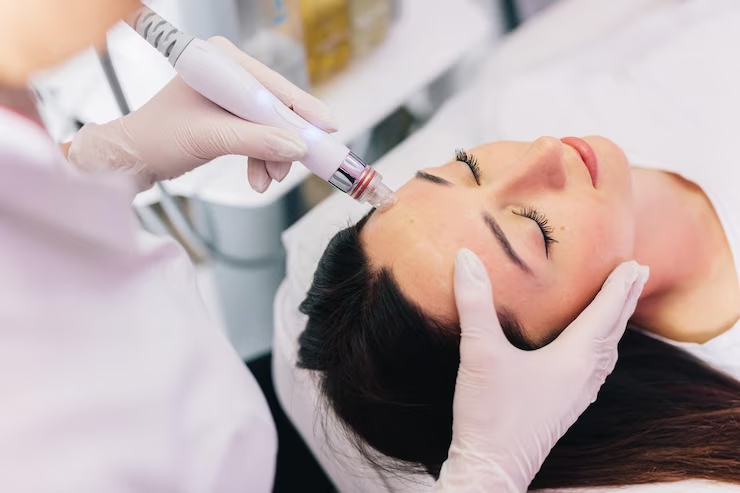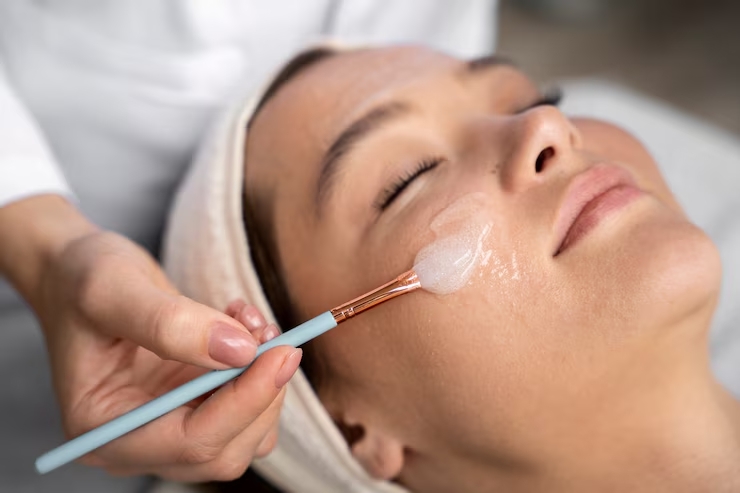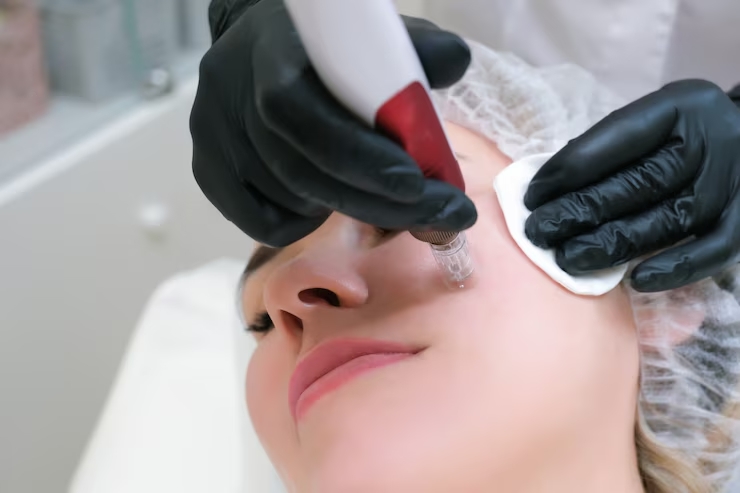A Hydrafacial treatment is a next-level skincare procedure that has taken the beauty industry by storm. Known for its ability to deeply cleanse, exfoliate, and hydrate the skin in a single session, it’s loved by celebrities and skincare enthusiasts alike.
Unlike traditional facials, this treatment uses a special vortex suction technology to remove impurities while infusing the skin with nourishing serums. The result? Glowing, refreshed, and youthful-looking skin—without the irritation or downtime of harsher treatments.
But is it the right choice for everyone? While Hydrafacial offers multiple benefits, it also has some limitations you should know about. In this guide, we’ll explore both the pros and cons of Hydrafacial treatment so you can decide if it’s worth adding to your skincare routine.
What is a Hydrafacial Treatment?
A Hydrafacial treatment is an advanced skincare procedure designed to deeply cleanse, exfoliate, and hydrate the skin—all in one session. Unlike regular facials, it uses a vortex suction technology to remove dirt, oil, and dead skin cells while infusing the skin with nourishing serums. The Hydrafacial treatment follows a multi-step process to refresh and rejuvenate the skin:
- Cleansing & Exfoliation – Removes dead skin cells and preps the skin.
- Gentle Extraction – Uses suction to clear out clogged pores.
- Hydration Boost – Infuses the skin with moisturizing serums.
- Antioxidant Infusion – Delivers nutrients to protect and brighten the skin.
This treatment is suitable for all skin types, including dry, oily, combination, and sensitive skin. Since it’s non-invasive and painless, it’s a great option for anyone looking to achieve radiant, healthy skin without irritation or downtime.
Pros of Hydrafacial Treatment (Benefits)
Hydrafacial isn’t just another facial—it’s a deep-cleansing, hydrating, and skin-rejuvenating treatment packed with multiple benefits. Here’s why it’s a favorite among skincare experts:
1. Deep Cleansing & Exfoliation
This treatment uses vortex suction technology to gently remove dirt, oil, and dead skin cells, leaving your skin instantly fresher and smoother. Unlike harsh scrubs, it exfoliates without irritation, making it safe even for sensitive skin.
2. Instant Hydration
Hydrafacial infuses the skin with a blend of moisturizing serums, hyaluronic acid, and antioxidants, restoring lost hydration and giving your face a plump, dewy glow.
3. Non-Invasive & Painless
Unlike chemical peels or microdermabrasion, Hydrafacial is a gentle, non-invasive treatment. There’s no pain, no downtime, and no peeling—just clean, refreshed skin in 30–45 minutes.
4. Suitable for All Skin Types
Whether you have dry, oily, combination, or sensitive skin, Hydrafacial works without causing irritation or breakouts. Even those with mild acne or rosacea can benefit.
5. Reduces Fine Lines & Wrinkles
By boosting collagen production and improving skin elasticity, Hydrafacial helps smooth out fine lines and wrinkles, making your skin look firmer and more youthful.
6. Improves Skin Texture & Tone
This treatment effectively reduces dullness, pigmentation, and uneven skin tone, revealing brighter, healthier-looking skin in just one session.
7. Minimizes Pores & Acne
The deep cleansing and extraction process removes excess oil and unclogs pores, helping to prevent blackheads, whiteheads, and breakouts. It also reduces pore size, giving the skin a smoother look.
8. Customizable for Your Skin Needs
One of the biggest advantages of Hydrafacial is that it can be tailored to target specific concerns. Clinics offer booster serums for anti-aging, brightening, acne control, and hydration, ensuring the treatment suits your skin’s unique needs.
Cons of Hydrafacial Treatment (Drawbacks)
While Hydrafacial treatment offers multiple skin benefits, it’s not a perfect solution for everyone. Here are some potential drawbacks to consider:
1. Temporary Results
Unlike treatments that offer long-lasting changes, the effects of Hydrafacial—hydration, glow, and smoothness—typically last for a few weeks. To maintain the results, regular sessions (once a month) are recommended, which can add up over time.
2. Costly Compared to Other Facials
A Hydrafacial treatment is more expensive than traditional facials. The advanced technology, high-quality serums, and instant results justify the price, but it may not fit everyone’s budget. If you’re looking for an affordable skincare routine, this might not be the best option.
3. Not Suitable for Severe Acne or Skin Conditions
While Hydrafacial works well for mild acne and clogged pores, it is not recommended for individuals with severe acne, active skin infections, or conditions like eczema and rosacea flare-ups. The suction process may further irritate inflamed skin.
4. Mild Redness or Sensitivity Post-Treatment
Although the treatment is gentle and non-invasive, some people may experience temporary redness, slight irritation, or sensitivity, especially those with very sensitive skin. However, these effects usually subside within a few hours.
Who Should & Shouldn’t Get a Hydrafacial?
Hydrafacial is a versatile treatment that works for many skin types, but it’s not suitable for everyone. Here’s who can benefit the most and who should be cautious before trying it.
Who Should Get a Hydrafacial?
This treatment is ideal for individuals looking for hydration, glow, and deep cleansing without harsh side effects. It works best for those with:
-
- Dull & Dehydrated Skin—Boosts moisture levels and restores radiance.
- Mild Acne & Congested Pores—Removes dirt, oil, and blackheads.
- Uneven Skin Tone & Texture—Reduces pigmentation and improves smoothness.
- Fine Lines & Early Signs of Aging—Plumps and firms the skin for a youthful look.
- Sensitive Skin—Unlike harsh peels, Hydrafacial is gentle and non-irritating.
Who Should Avoid a Hydrafacial?
While Hydrafacial is safe for most, it’s not recommended for:
- People with Active Skin Infections—Conditions like cold sores or open wounds can worsen with treatment.
- Severe Acne or Cystic Breakouts—The suction process may further irritate inflamed skin.
- Highly Sensitive or Reactive Skin—Those prone to redness, rosacea flares, or allergies should consult a dermatologist first.
- Recent Chemical Peel or Laser Treatment Patients—Skin needs time to heal before another procedure.
Hydrafacial Treatment Cost in India
The cost of Hydrafacial treatments in India varies based on several factors, including location, clinic reputation, and additional services. Here’s a breakdown to help you understand the pricing landscape:
| City | Price Range (per session) |
| Hydrafacial Cost in Delhi | Rs. 3,000 – Rs. 12,000 |
| Hydrafacial Cost in Mumbai | Rs. 4,000 – Rs. 13,000 |
| Hydrafacial Cost in Bangalore | Rs. 4,000 – Rs. 13,000 |
| Hydrafacial Cost in Chennai | Rs. 3,000 – Rs. 8,500 |
| Hydrafacial Cost in Kolkata | Rs. 3,000 – Rs. 8,500 |
| Hydrafacial Cost in Hyderabad | Rs. 4,000 – Rs. 12,000 |
| Hydrafacial Cost in Pune | Rs. 2,000 – Rs. 6,500 |
| Hydrafacial Cost in Ahmedabad | Rs. 4,000 – Rs. 12,000 |
| Hydrafacial Cost in Jaipur | Rs. 2,000 – Rs. 6,500 |
| Hydrafacial Cost in Chandigarh | Rs. 3,500 – Rs. 7,000 |
| Hydrafacial Cost in Kochi | Rs. 3,000 – Rs. 8,000 |
| Hydrafacial Cost in Vijayawada | Rs. 4,000 – Rs. 13,000 |
| Hydrafacial Cost in Vizag | Rs. 4,000 – Rs. 10,000 |
Factors Influencing Hydrafacial Pricing
Several elements contribute to the cost of a Hydrafacial session:
- Clinic Reputation and Expertise: Established clinics with experienced dermatologists may charge higher fees due to their proven track record and advanced technology.
- Location: Clinics situated in metropolitan areas or prime locations often have higher operational costs, which can reflect in the treatment pricing.
- Treatment Package: Customized packages tailored to individual skin concerns may alter the overall cost. Some clinics offer bundled sessions at discounted rates.
- Technology and Equipment: The use of state-of-the-art equipment and high-quality serums can influence the price, ensuring better results and safety.
- Additional Procedures: Combining Hydrafacial with other treatments or add-ons like boosters can increase the total expense.
- Pre- and Post-Treatment Care: Expenses for initial consultations, follow-up visits, and recommended skincare products can add to the overall cost.
Understanding these factors can help you make an informed decision and budget accordingly for your Hydrafacial treatment. It’s advisable to consult with multiple clinics to compare services and pricing before proceeding.
How Long Do The Results of Hydrafacial Last?
The results of a Hydrafacial typically last 5 to 7 days, with some people experiencing benefits for up to 15 days. Since the treatment provides deep hydration and exfoliation, regular sessions are needed to maintain glowing skin. Over time, monthly treatments can improve skin texture, tone, and hydration levels, keeping your skin fresh and rejuvenated.
How Often Should I Get a Hydrafacial?
For best results, dermatologists recommend getting a Hydrafacial once a month. This frequency helps maintain hydration, clear pores, and even skin tone. However, if you have specific skin concerns like acne or dullness, your dermatologist may suggest bi-weekly sessions initially, followed by monthly maintenance. Since Hydrafacial is gentle and non-invasive, it’s safe to do it regularly.
Can I Wear Makeup After a Hydrafacial?
It’s best to avoid makeup for at least 6 to 12 hours after a Hydrafacial to let your skin absorb the benefits of the treatment. Since Hydrafacial deeply cleanses, hydrates, and exfoliates, applying makeup immediately might clog pores. Your skin will already have a natural glow, so skipping foundation for a day allows for better absorption of skincare products.
Is There Any Aftercare Required After a Hydrafacial?
There’s minimal aftercare needed after a Hydrafacial, but you should avoid sun exposure, exfoliants, and harsh skincare products for 24–48 hours. Using a gentle moisturizer and sunscreen helps maintain the treatment’s benefits. Drinking plenty of water also keeps the skin hydrated. Since Hydrafacial is a non-invasive treatment, there’s no downtime, and you can resume normal activities immediately.
Does a Hydrafacial Hurt or Cause Side Effects?
A Hydrafacial is painless and feels like a cool, gentle massage on the skin. Most people experience zero discomfort during the treatment. However, some may have mild redness or sensitivity, which typically subsides within a few hours. Unlike harsh treatments, Hydrafacial doesn’t cause peeling or irritation, making it suitable for sensitive skin types as well.
Conclusion: Is Hydrafacial Worth It?
Hydrafacial is a top choice for deep cleansing, hydration, and instant glow with zero downtime. It’s ideal for dull, dehydrated skin, mild acne, and clogged pores, making it perfect for sensitive skin types. However, it’s not suitable for severe acne, active infections, or deep scars, and requires regular sessions for long-term results.
For expert care, Hana Aesthetics offers advanced Hydrafacial treatments with cutting-edge technology and personalized skincare. Their team ensures safe, effective, and visible results for all skin types. If you want radiant, refreshed skin, Hana Aesthetics is the best place to get your Hydrafacial. Book your appointment now!



